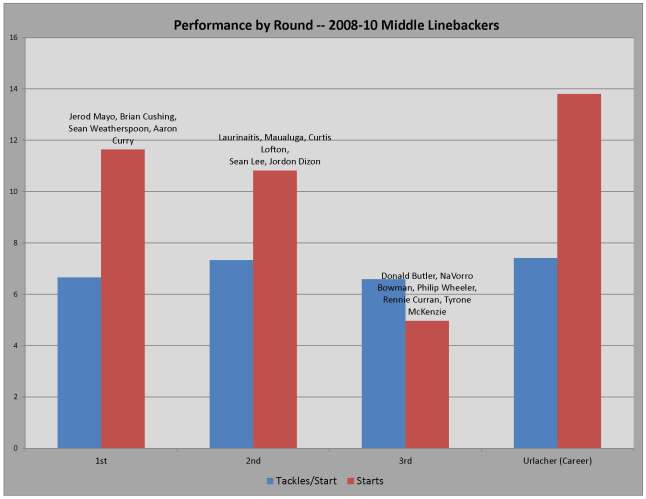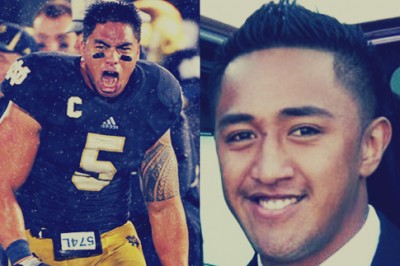sportsthink’s Pop Culture department, TMZportsthink (sportsthink’s girlfriend), has followed the Manti Te’o saga much more closely than sporsthink’s Draft Analysts have. The cast of characters (real and fictional) alleged to have taken part in the world’s most famous catfishing scandal made heads spin in the sportsthink War Room. So sportsthink has been, noticeably I’m sure, devoid of Manti Te’o coverage.
As the time approaches to issue sportsthink’s eagerly awaited Top 50 2013 NFL Draft Prospects, however, our thoughts necessarily turn towards Te’o (and, only because it invokes laughter in the War Room, “Lennay Kekua”). sportsthink initially penciled Te’o somewhere into the Top 50. After all, Te’o has exceptional instincts, hits like a freight train, and relentlessly guided the Irish to finishes near the top of the FBS rankings in defense the past few seasons — his struggles against Alabama and 40 yard dash times notwithstanding.
One issue gives the sportsthink researchers pause. Te’o is, more or less, a two-down linebacker. He chalked up a few interceptions and passes defended this year. But his work in coverage tended to be less acrobatic and more blue-collar: he collected most of his interceptions off deflections and misreads by quarterbacks facing zone coverage. Given that Te’o will, generally speaking, make his NFL living on 1st and 2nd downs, sportsthink wondered just how much teams should value those potential contributions. Essentially, we looked to test the maxim that teams should only draft three-down players in the first round.
The chart below looks to inform that question. sportsthink pulled tackling statistics for all linebackers in the 2008-2010 draft classes who were selected primarily for their play in space, not as outside rushers (e.g., those primarily playing in space, such as in the middle or on the outside in a 4-3 set). sportsthink then plotted the average tackles per game for such a linebacker (collectively referred to as “middle linebackers”) drafted in each of the first three rounds. The chart also shows the average number of starts a first-, second-, or third-round middle linebacker selection made per year.
Those draft classes included Jerod Mayo, Brian Cushing, Curtis Lofton, and NaVorro Bowman, in addition to less-decorated players, some of whom are noted in the chart. Although the sample could arguably be modified, the draftees selected should have all had at least three seasons to establish themselves as NFL players.
A few more notes about the chart. The data set uses “starts” as a proxy for limiting the body of work on which to judge the players to only in those games where they were given a fair opportunity to succeed — suffering on the bench behind an established veteran didn’t count against the players’ aggregate tackling numbers. However, this necessarily required excluding tackles accrued on special teams or in sub packages, as a player who accrued 40 tackles with only one start would inflate the statistics.
A low average number of starts could be due to injuries (Keith Rivers), lack of playing time (several third-round selections, for example), failing to make the cut (ditto), or all of the above.
Why good is this, you ask? It shows a couple of things. First, it shows that good, downhill middle linebackers are available on Day 2. When those players started, they accrued tackles at virtually the same rate as first-round selections. Granted, this excludes the players who never reached NFL prominence; more about them in a second. Also, plotting tackles doesn’t account for a lot of statistics that might prompt teams to upgrade a player to first-round value: examples include passes defensed, tackles for loss, and fumbles forced. But it’s still a useful statistic.
The chart also suggests that reliable middle linebackers are still awfully plentiful in the second round, but become much harder to find in the third. Even considering Jordon Dizon’s short stint in Detroit, second-rounders still started at a rate nearly that of first-rounders. By the third round, though, the pickings got a lot slimmer. Some players never panned out (Rennie Curran); others have bounced around the League with middling results (Dan Connor). The third round is very much a diamonds-in-the-rough situation.
Lessons for NFL teams? Obviously the progress of each draft will dictate when a given player, including a given middle linebacker, represents good value. Insofar as teams are considering selecting a two-down linebacker in the first two days of the draft, however, a fair reading of the data suggests that good prospects are just as likely to be available with pick 45 as pick 15.
As for Manti: it was a joy to watch him toss aside blockers and sniff out screen plays at Notre Dame; he may do the same in the NFL. But unless they’re hoping to parlay a Lennay Kekua appearance in the Green Room into a marketing campaign, teams should probably stay away from Manti in the first round.


